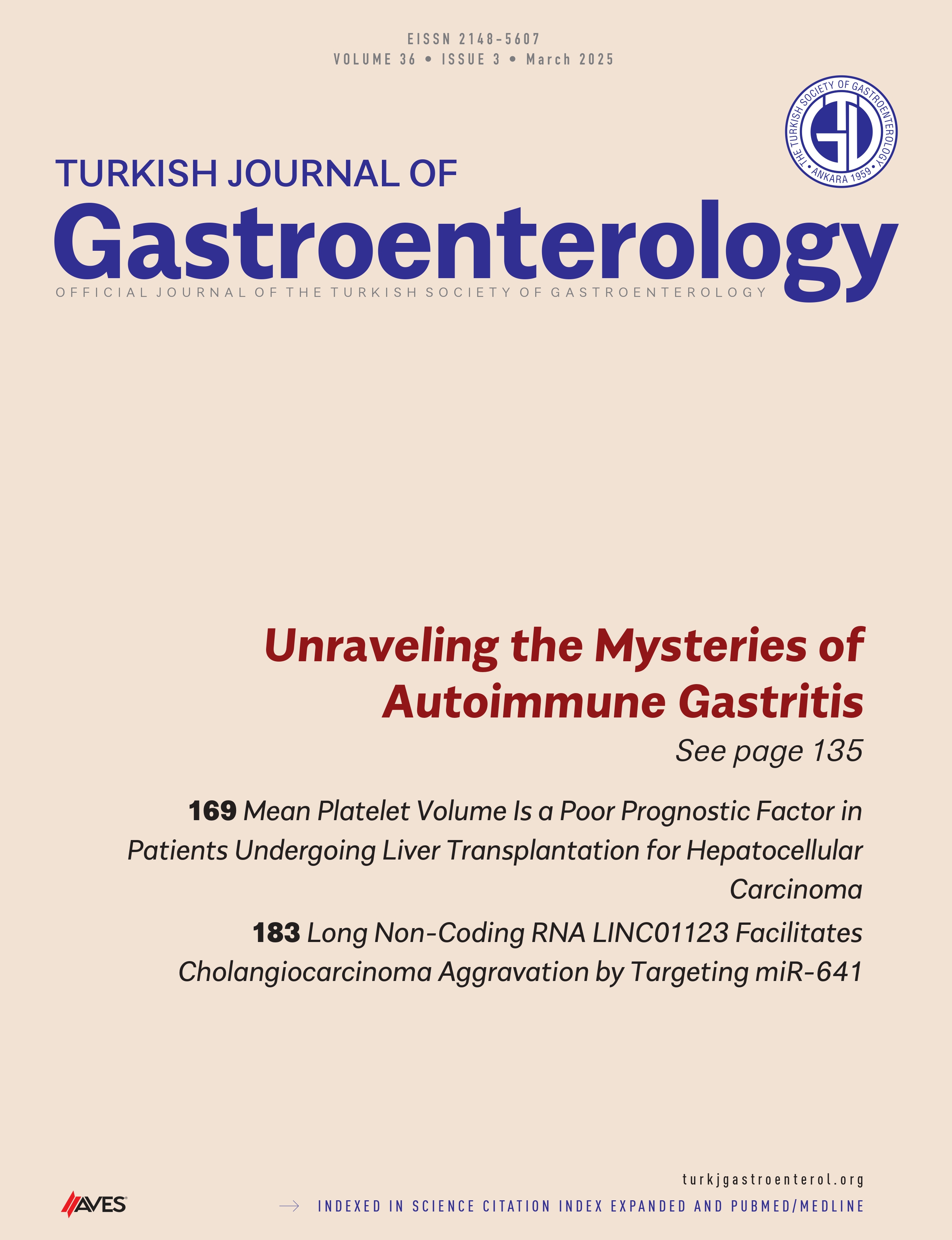Liver Transplantation for Autoimmune Hepatitis: 20 Years of Tertiary Centre Experience
Main Article Content
Abstract
Background/Aims: We analyzed the frequency of complications and survival rates in patients with autoimmune hepatitis (AIH) who underwent liver transplantation at a high-volume transplant center.
Materials and Methods: Patients who underwent transplantation for AIH at the İnönü University Liver Transplantation Institute between January 2002 and December 2021 were included. Patients with a confirmed diagnosis of AIH, without concomitant chronic liver disease, were included in the study.
Results: We included 51 patients (31 female) with a median age of 38.5 years (18-65 years). The 12-month and 60-month survival rates were 86.3% and 80.9%, respectively. During a median 2.22 years follow-up, 9 patients died. Six patients died due to systemic infection, 1 due to biliary complications, and 2 patients due to graft rejection. Autoimmune hepatitis recurrence developed in 6 (11%) patients. Overall, biliary complications developed in 56% (28/51) of patients following liver transplantation, and graft rejection occurred in 22% (11/51) of patients.
Conclusion: Our results suggest that the outcome of AIH following liver transplantation is good, with a survival rate of up to 80%. Posttransplant biliary complications are common; therefore, close follow-up is necessary.
Cite this article as: Sağlam O, Harputluoğlu MMM, Bilgiç Y, Yılmaz S, Yağın FH, Efe C. Liver transplantation for autoimmune hepatitis: 20 years of tertiary centre experience. Turk J Gastroenterol. 2025;36(3):145-151.
Article Details
References
1. Lohse AW, Chazouillères O, Dalekos G. EASL Clinical Practice Guidelines: autoimmune hepatitis. J Hepatol. 2015;63(4):971-1004. [CrossRef]
2. Özaslan E, Günşar F, Çiftçibaşı Örmeci A, et al. Diagnosis and treatment of autoimmune hepatitis: questions, answers, and illustrative cases: endorsed by autoimmune liver diseases Special Interest Group, Turkish association for the study of liver. Turk J Gastroenterol. 2023;34(suppl 2):S1-S33. [CrossRef]
3. Heinemann M, Adam R, Berenguer M, et al. Longterm survival after liver transplantation for autoimmune hepatitis: results from the European liver transplant registry. Liver Transpl. 2020;26(7):866-877. [CrossRef]
4. Montano-Loza AJ, Mason AL, Ma M, Bastiampillai RJ, Bain VG, Tandon P. Risk factors for recurrence of autoimmune hepatitis after liver transplantation. Liver Transpl. 2009;15(10):1254-1261. [CrossRef]
5. Adam R, Karam V, Cailliez V, et al. Annual Report of the European Liver Transplant Registry (ELTR) −50-year evolution of liver transplantation. Transpl Int. 2018;31(12):1293-1317. [CrossRef]
6. Montano-Loza AJ, Ronca V, Ebadi M, et al. Risk factors and outcomes associated with recurrent autoimmune hepatitis following liver transplantation. J Hepatol. 2022;77(1):84-97. [CrossRef]
7. Harputluoglu M, Caliskan AR, Akbulut S. Autoimmune hepatitis and liver transplantation: indications, and recurrent and de novo autoimmune hepatitis. World J Transplant. 2022;12(3). [CrossRef]
8. Carbone M, Neuberger JM. Autoimmune liver disease, autoimmunity and liver transplantation. J Hepatol. 2014;60(1):210-223. [CrossRef]
9. Onder AH, Bengi G, Ozbilgin M, Unek T, Astarcioglu I, Akarsu M. Analysis of socioeconomic status and other factors affecting patient-graft survival in patients undergoing liver transplantation. Hepatol Forum. 2020;1(1):25-36. [CrossRef]
10. Duclos-Vallee JC, Sebagh M. Recurrence of autoimmune disease, primary sclerosing cholangitis, primary biliary cirrhosis, and autoimmune hepatitis after liver transplantation. Liver Transpl. 2009;15(suppl 2):S25-S34. [CrossRef]
11. Krishnamoorthy TL, Miezynska-Kurtycz J, Hodson J, et al. Longterm corticosteroid use after liver transplantation for autoimmune hepatitis is safe and associated with a lower incidence of recurrent disease. Liver Transpl. 2016;22(1):34-41. [CrossRef]
12. Mack CL, Adams D, Assis DN, et al. Diagnosis and management of autoimmune hepatitis in adults and children: 2019 practice guidance and guidelines from the American Association for the Study of Liver Diseases. Hepatology. 2020;72(2):671-722. [CrossRef]
13. Lee HW, Shah NH, Lee SK. An update on endoscopic management of post-liver transplant biliary complications. Clin Endosc. 2017;50(5):451-463. [CrossRef]
14. Tashiro H, Itamoto T, Sasaki T, et al. Biliary complications after duct-to-duct biliary reconstruction in living-donor liver transplantation: causes and treatment. World J Surg. 2007;31(11):2222-2229. [CrossRef]
15. Fisher RA. Living donor liver transplantation: eliminating the wait for death in end-stage liver disease? Nat Rev Gastroenterol Hepatol. 2017;14(6):373-382. [CrossRef]
16. Forde JJ, Bhamidimarri KR. Management of biliary complications in liver transplant recipients. Clin Liver Dis. 2022;26(1):81-99. [CrossRef]
17. Boeva I, Karagyozov PI, Tishkov I. Post-liver transplant biliary complications: current knowledge and therapeutic advances. World J Hepatol. 2021;13(1):66-79. [CrossRef]
18. Chouik Y, Francoz C, De Martin E, et al. Liver transplantation for autoimmune hepatitis: pre-transplant does not predict the early post-transplant outcome. Liver Int. 2023;43(4):906-916. [CrossRef]
19. Barbetta A, Aljehani M, Kim M, et al. Meta-analysis and meta-regression of outcomes for adult living donor liver transplantation versus deceased donor liver transplantation. Am J Transplant. 2021;21(7):2399-2412. [CrossRef]


